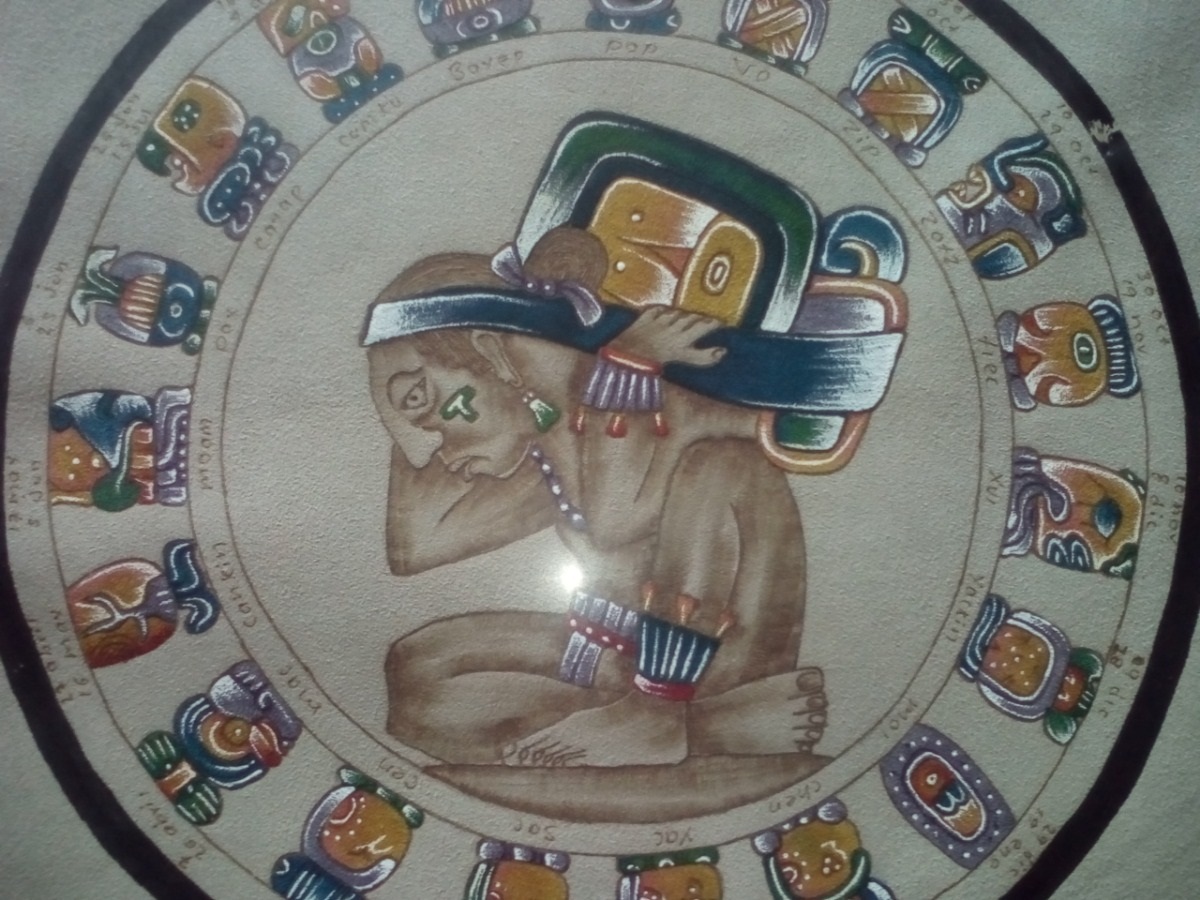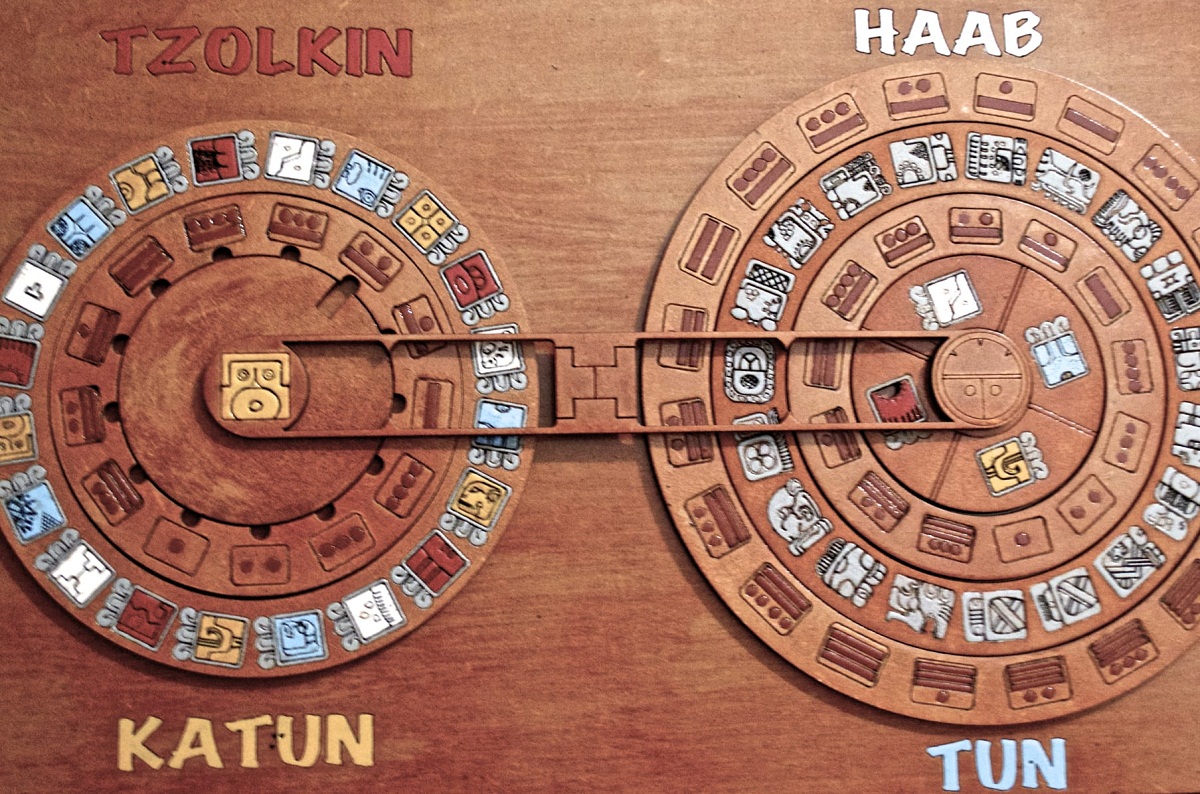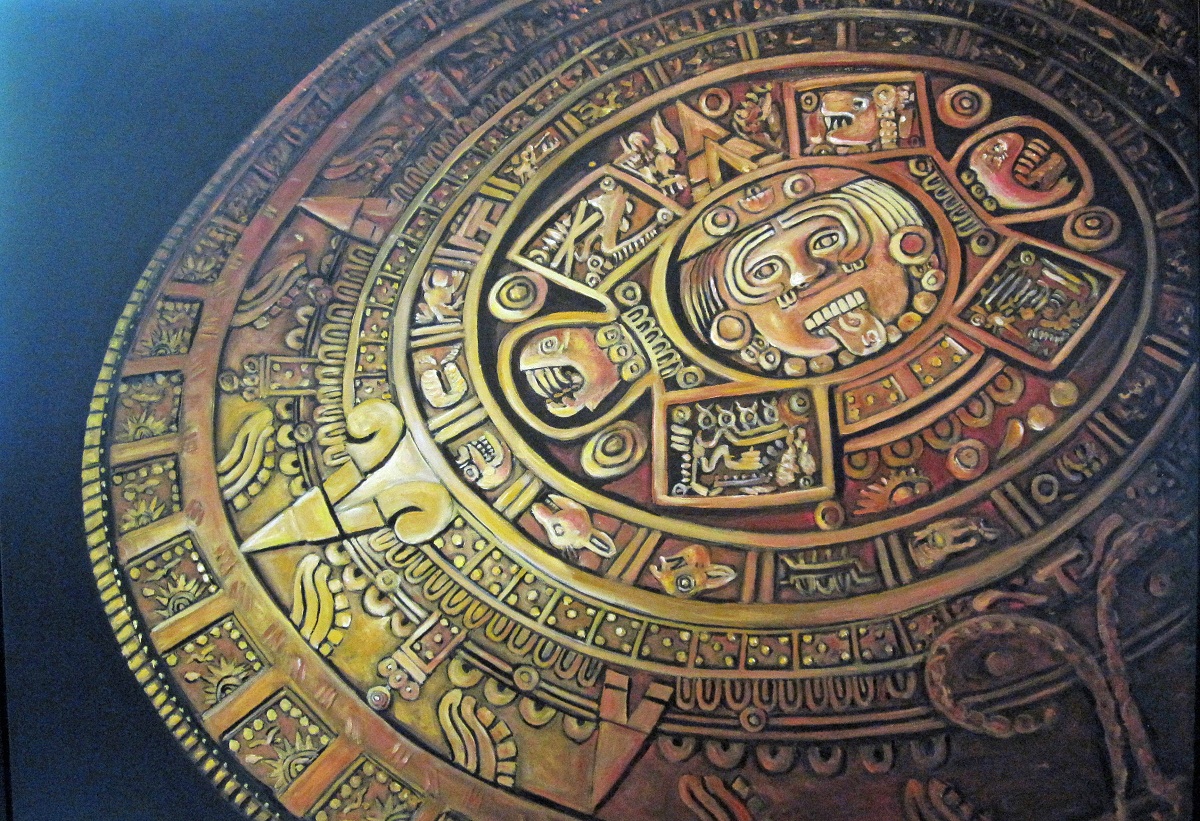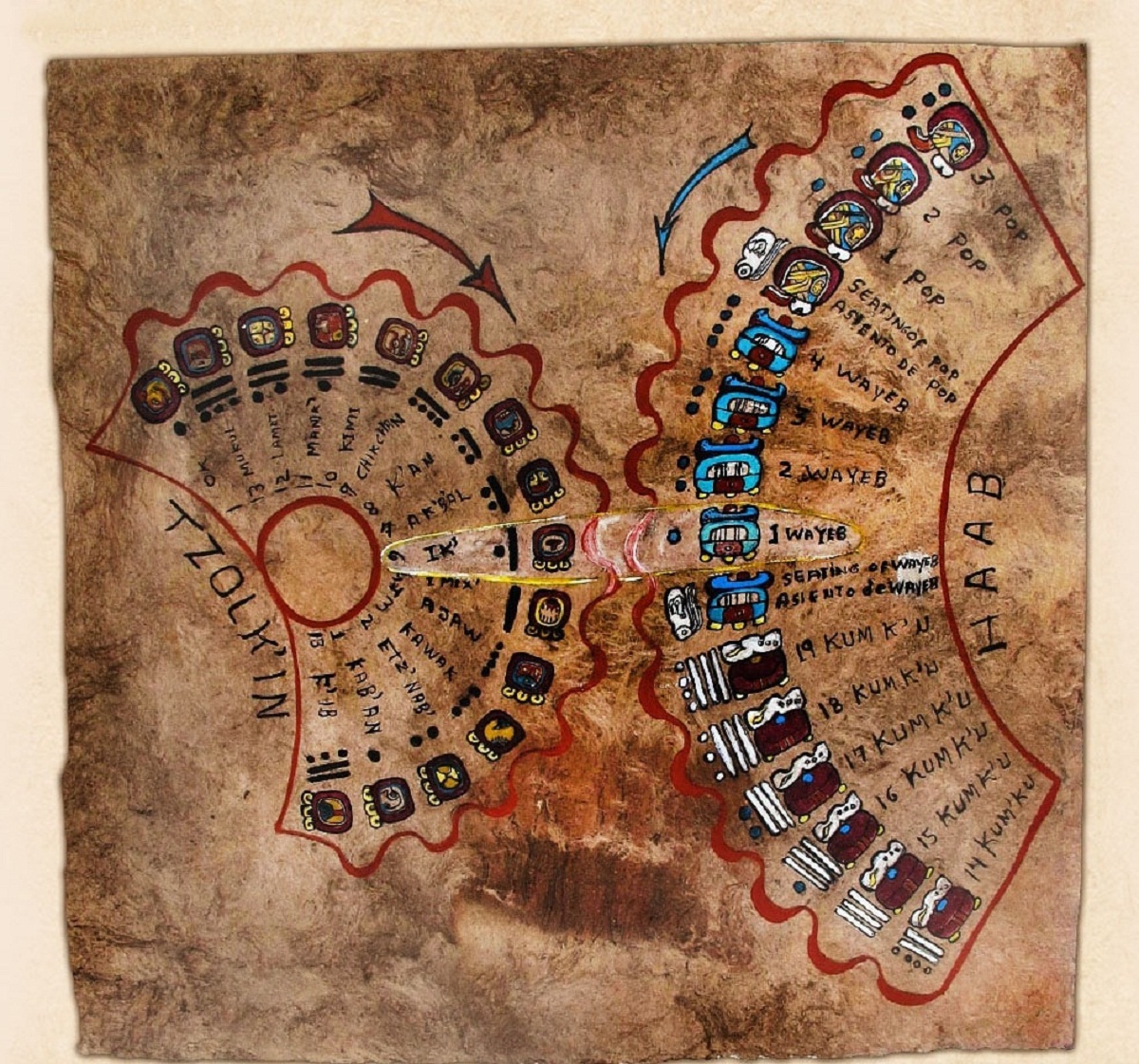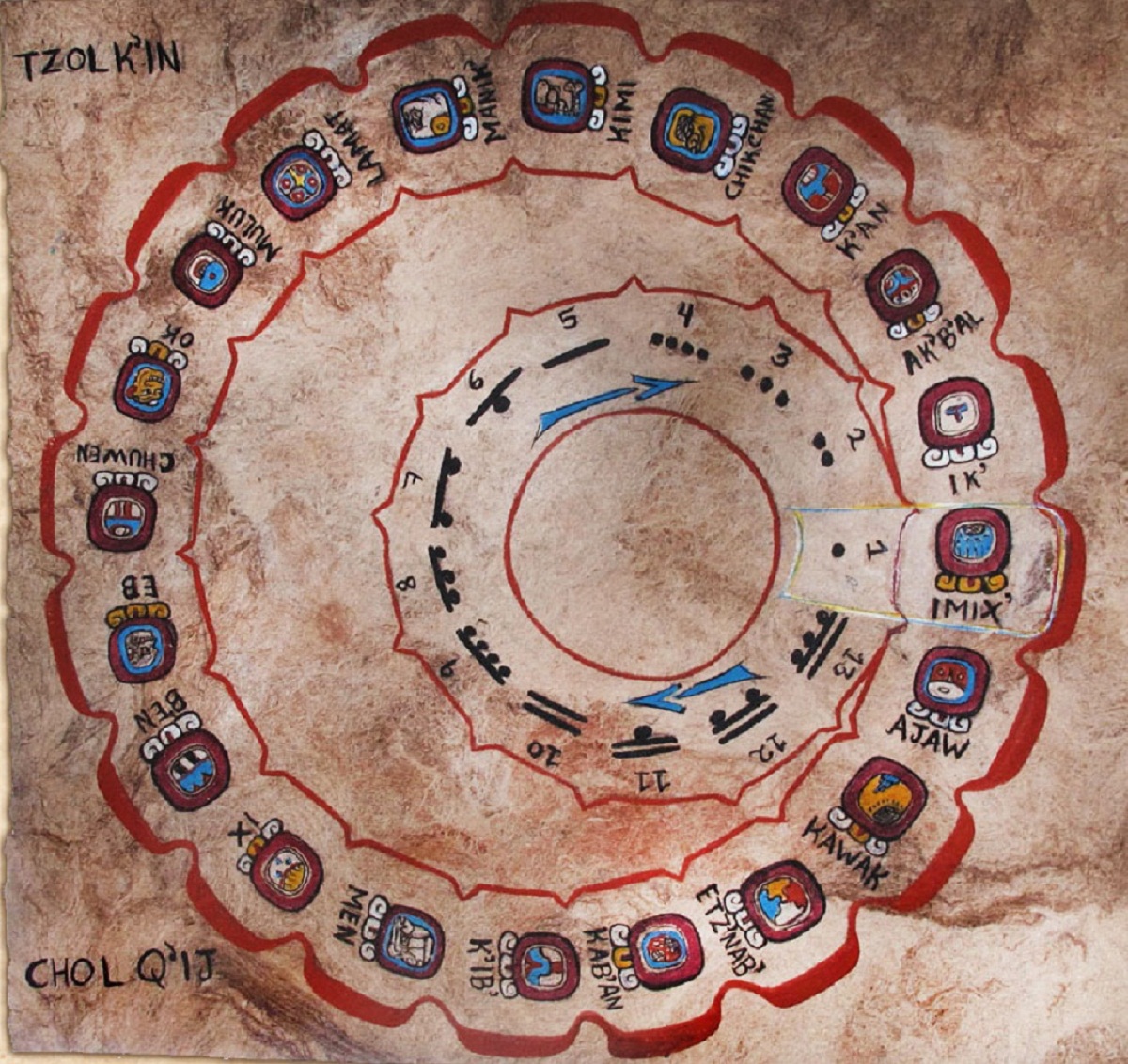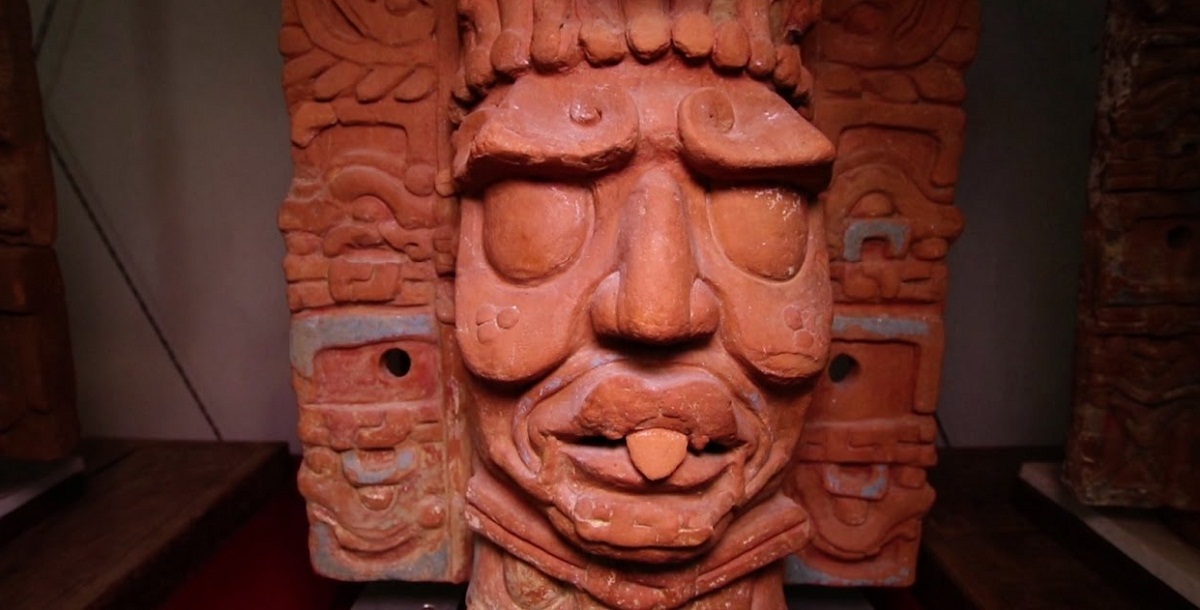Through this interesting informative article, you will know everything about the Mayan calendar in relation to its meaning and mysticism. Also about the lunar calendar, the months and more, referring to this wonderful topic. Do not miss it!
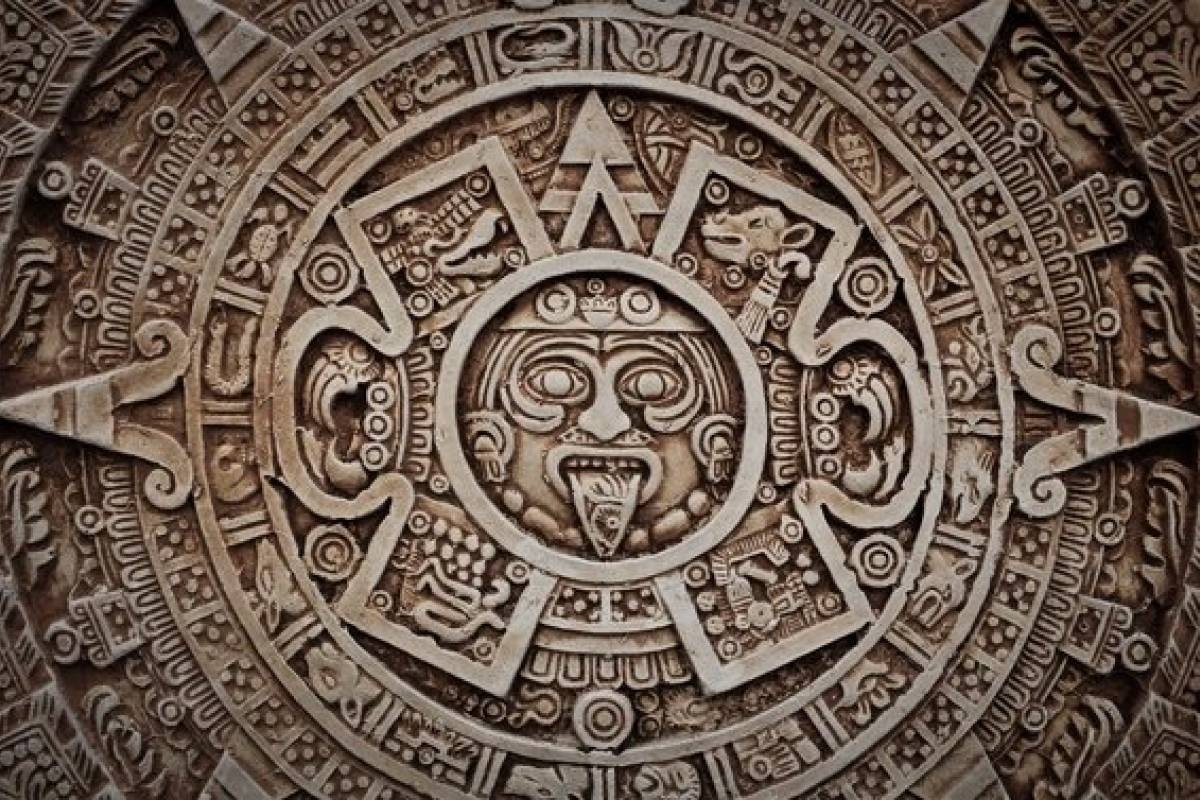
What is the Mayan calendar about?
It consists of a measure of time used by this ethnic group through astronomical data that allowed recording periodic cycles, so the Mayan calendar was made up of other almanacs, including the Haab calendar, which corresponded to 365 Earth days.
Likewise, the Mayan calendar was also made up of the Tzolkin calendar that oscillates in two hundred and sixty terrestrial days and the calendar wheel that was the result of uniting the previous almanacs.
It is essential to note that this Mayan calendar was designed by this ethnic group that was in charge of inhabiting Mesoamerica between 2000 BC and 1697 AD at the time that the fall of this empire at the hands of the Spanish during the conquest became evident.
The main objective of the Mayan calendar was to recognize religious festivities in addition to highlighting the appropriate dates to sow food items, even for daily actions.
Well, the date of birth of each of the inhabitants of the ethnic group was a piece of information that facilitated understanding the life cycles of each person and making predictions regarding their near future through the help of the Mayan calendar.
The days, months and years that make up the Mayan calendar
In this Mayan calendar, several ways of counting time are integrated, being the following, in the first instance the sacred calendar known by the term tzolkin o bucxok that oscillated in a duration of two hundred and sixty days.
Then he integrates the best known solar cycle with the word habb which consists of a duration of three hundred and sixty-five days in addition to a calendar wheel which consists of fifty-two years, was also made up of a long count that oscillated in a period of 5200 years.
They even created in the Mayan calendar the moon count that made up eighteen lunar months there was also another almanac called the venus account consisting of five hundred and eighty-four days or kin.
Lastly it is mentioned the account of the lords of the night which was made up of nine days and others. It is important to note that this Mayan calendar was cyclical and lasted around two millennia and showed an advanced hieroglyphic writing in relation to other ethnic groups that inhabited the Mesoamerican region.
This Mayan calendar was repeated when reaching fifty-two years, so the long count began on day number 0.0.0.0.0 4 called ajau and 8 cumkú, which is the Mayan writing.
This translates as August 11 of the year 3114 BC in what is known as the Gregorian calendar that was widely used in Europe and after the conquest it was used worldwide.
Although many scholars of the Mayan calendar comment that the appropriate date is August 13, 3114 BC as the most appropriate date to start the long count.
December 21, 2012 AD is established as the closing date. Therefore, this period oscillates in 5.124.36 terrestrial or solar years and in the Mayan calendar it is equivalent to 5.200 tunes with cycles of three hundred and sixty days called Tun, which made up the day or kin that made up the amount of 1.872.000 kin.
You can see in this Mayan calendar five repetitions or five layers for this Mayan ethnic group called long accounts that make up this enormous cycle of 26.000 tunes, which is equivalent to 25.626,8 years, so you can see that this Mayan calendar is a great circle that is integrated every one of the 5.200 tunes.
You should also be aware that the number is 26.000 tunes and was made up of five long accounts where the fifth and last long account ends with an astronomical event known as the solstice that occurred on December 21-22, 2012 of the Christian religion .
It is essential that you know that in these solstices of the Earth they occur when the ecliptic plane, which is the line along which the sun moves around the Earth, intersects with the equatorial plane of the Galaxy, which is a segment that divides the Milky Way into two parts of equal size.
Even the Mayan calendar was studied by a special caste in the Mayan ethnic group known as the Mayan priestly caste and they used the word oh kin To identify them, they were in charge of carrying out mathematical and astronomical studies to interpret them according to their religious worldview.
In addition to the Mayan culture that allowed knowing the years that began, those that would come and how it affected the destiny of the inhabitants of this ethnic group according to research carried out by scholars, the Mayan calendar was already evident in other cultures such as the case of the Olmec.
Which corresponds to the preclassic period of Mesoamerica, although this almanac is typical of the Mayan culture, it is similar to the Aztec calendar, it is said that the Mayan calendar was used throughout Mesoamerica by different ethnic groups due to its excellent functionality for the cultivation of food items.
Representation of the Mayan calendar
With regard to the first system that makes up the Mayan calendar is the tzolkin made up of two hundred and sixty days called kin, being made up of twenty months, they are combined with thirteen figures or numerals, others confuse it with thirteen moons.
This calendar was integrated together with the almanac haab it was made up of three hundred and sixty-five days that were divided into eighteen months called unials.
Each one made up of twenty days or kin, plus five extra days that were known by the term uayeb, thereby forming a cycle that lasted around fifty-two tunes or haabs, which was made up of 18980 kin, which were the days.
With regard to the denomination of long count, it was used by the ethnic group of this culture in the Mayan calendar to be able to recognize when an event had occurred between the Tzolkin and Haab calendars, since their system was vigesimal.
The units were multiples of twenty according to their place in the calendar from right to left in the corresponding digit, in addition to highlighting the second position that they used and symbolized 18 x 20, which was equal to three hundred and sixty days.
In this Mayan calendar, there are inscriptions or hieroglyphs that belong to the long count and are based on what they identified as the lunar series, which was another almanac that made up the Mayan calendar and provided information regarding the phases of the moon.
This ethnic group was even helped in the Mayan calendar with the solar cycles known as equinoxes and solstices in addition to the Venusian cycles of two hundred and sixty days that correspond to the appearances in the sky and the links of the Venus star both at dawn and at night.
Therefore, the events that they studied in this ethnic group were known as adverse and even malignant. Due to this, wars were scheduled so that they coincided with the phases of this cycle of the Mayan calendar.
In their culture, these cycles of the Mayan calendar were related to various deities and cosmic matters, just as the fifth sun corresponds to their knowledge as the five stages that the earth required to form according to this Mayan ethnic group.
Being related to the cycles of the moon to start the period known in the Mayan calendar as the sixth sun, which is related to the return of Kukulkan, so the lunar account consists of eighteen lunar months that make up about five hundred and thirty-one days.
During this course of time, around four total solar eclipses and even lunar eclipses can occur, which will intervene at intervals of six lunar months.
From what they knew in their Mayan calendar that the next eclipse to take place was predicted for August 21, 2017, being the last of this quartet carried out in the eighteen lunar months that corresponds to March 09, 2016.
Tzolkin calendar system
This system that corresponds to the Mayan calendar is translated as the count of days and consists of a duration of two hundred and sixty days, it is said that it is related to the duration of human gestation.
Many agree that it is related to the planet Venus, it was used to celebrate religious festivities in addition to letting you know when the rains came.
It even allowed this phase of the Mayan calendar to know the right time for hunting and fishing, it also helped to know the near future of the inhabitants of this ethnic group.
For these students of the stars in the firmament, Venus, the second planet in the solar system, took around 224,7 days to turn around, being its annual period, but from Earth a cycle of five hundred and eighty-four days is observed, which translates into 2247 tzolkines.
Being its multiple two hundred and sixty, although it is the planet Mars that spends seven hundred and eighty days in its orbit, which is equivalent to three periods of two hundred and sixty days, equal to three tzolkines.
Therefore, in the Mayan calendar, the long count is made up of 5126.36 years, which is equivalent to two hundred and sixty katuns, these in turn form 7200 tzolkines and to form this great wheel, five long accounts are required, consisting of 25.626,8, which is equivalent to 1300. katunes being equal to 36000 tzolkines.
In relation to this almanac that was part of the Mayan calendar, it is shown today that there are indigenous communities in the territories of Guatemala that use this date system to carry out the cultivation of corn efficiently, demonstrating the usefulness of this Mayan calendar in the activities of agriculture.
This time was distributed in nineteen months that were made up of twenty solar days each to be identified with the names of deities each month, being the following:
| day number | solar day called kim | Months known as uinal |
| 01 | imix | Pop |
| 02 | Ik | Uo |
| 03 | ak'bal | Zip |
| 04 | Khan | Zotz |
| 05 | chikchan | tzec |
| 06 | cimi | xul |
| 07 | Manik | Yaxin |
| 08 | The mat | Mol |
| 09 | faucet | Chen |
| 10 | Ok | Yax |
| 11 | chuen | Zac |
| 12 | Eb | eh |
| 13 | Ben | Mac |
| 14 | Ix | kankin |
| 15 | Men | muwan |
| 16 | kib | Pax |
| 17 | Coat | kayak |
| 18 | Etz'nab | Cumku |
| 19 | bro | uayeb |
| 20 | ahau |
Haab almanac system
This almanac that is part of the Mayan calendar is responsible for measuring the time of the solar year and is divided into eighteen months each of twenty days and the last five days of the year are known by the term uayeb.
They were considered terrible days for this ethnic group and although they were dated, no chronological records were made during these days because they brought a bad omen for the population according to the Mayan calendar.
For each first day of each month in the Mayan calendar, it was represented with the symbol zero because it was the beginning of that month, being the primary basis for promoting religious festivals in a group manner.
To show at what specific moment the community rites were performed and the dates in which the specialists participated in the subject to be treated, the Mayan calendar is used.
It is important to note that the division of months in this Mayan calendar is equivalent to the divisions of the solar calendar and not as we are used to in the Gregorian calendar.
So the cycle of the Mayan calendar does not adjust to the natural movement of the Earth on its own orbit but is based on rational integers.
Made with the intention of making the periods of the cycles more feasible in order to make them synchronize, an example of them is the Haab almanac that allows the Mayan calendar to reach three hundred and sixty-five whole days to achieve synchronization with the other calendar called Tzolkin.
Long Count or initial series of the Mayan calendar
This part of the Mayan calendar had specific names for the months according to its vigesimal system and had the kin or solar day as its basic unit, and other periods of time were designated according to its multiples.
As it is the uinal which corresponded to twenty days and its equivalence was 20 kin, then it was followed by the tun which corresponds to 360 days and its equivalent was known as 18 uinal.
Later on, this denomination in the Mayan calendar was followed by the katun, which corresponds to 7200 days and its equivalent corresponded to 20 tun or 360 uinals, and finally, the baktun, which was equal to 144.000 days and its equivalent was 7200 uinals or 400 tunes, and even compared to 20 katuns.
To be able to count in the Mayan calendar, it is necessary to use the sequence of numbers separated by points, an example being the following 6.19.19.0.0, this is equivalent to 6 baktuns, 19 katuns, 19 tuns, 0 uinals and 0 kin.
Then the total of each of these numbers is calculated by their equality in solar days, which is equal to the kin, so the previous example is multiplied as follows: 6 x 144.000 + 19 x 7200 + 19 x 360 + 0 .20 + 0 x 1 = 1.007.640 days or kin.
There were also other words in the Mayan calendar that referred to longer times but were rarely used by this ethnic group, but it is worth knowing them, being the following: piktún, kalabtún, kinchinltún and alautún.
Therefore, 20 baktuns will make up the amount of a piktun that oscillates in 7890 years. Therefore, if you add the amount of twenty piktuns, they would make up a kalabtun that is equivalent to 57.600.000 kin or days, which is equal to 157.810 years.
According to the investigations carried out by the GMT Goodman – Martínez – Thompson organization, it was established by the archaeologist named John Erick Sidney Thompson.
According to this researcher, in the Mayan calendar the number 0.0.0.0.0 is equivalent to the Julian day number 584.283, so it is equal to August 11 of the year 3114 BC, being a constant correlation number in the Gregorian and Julian calendars, it is also used in the conversion dates of the Mayan calendar.
For what it serves to be transmuted the dates from the Mayan calendar to the dates of the Gregorian and Julian calendar without any inconvenience.
Another of the peculiarities of the figures of this ethnic culture corresponds to the figures in kin that can be transformed into cycles that can be reduced, such is the case of 9: 360 where 3 + 6 = 9.
Regarding the katuns, 7200 is equal to 7 + 2 = 9 and 144.000, the figures are added, obtaining 1 + 4 + 4 = 9. Like 1872000, it is equivalent to the sum of its figures 1 + 8 + 7 + 2 = 18 in the same way with the following quantities that correspond to the piktún and kalabtún.
As you can see, the number nine corresponds to the Mayan calendar and gives rise to the cosmology of the Mayan ethnic group by representing the Nine Lords of Time.
According to its mythology, it even belongs to the Nine Steps of the Temple of the Inscriptions, which is located in the town of Palenque in the state of Chiapas of the Aztec nation, being the tomb of one of the Mayan kings named k'inich Janaab'. Pakal.
In relation to the long count that is part of the Mayan calendar, it corresponds to five cyclical layers that are responsible for measuring time in different ways, being the following: one layer refers to 13 baktuns, the other layer is referred to 260 katuns, followed by another layer referring to 5200 tunes.
The fourth layer at 7200 tzolkines, the fifth being expressed in ahau, which covers the amount of 13 katuns or 93.600 kin or solar days. These figures can be simplified to nine, obtaining 360 tzolkines in the Mayan calendar.
With respect to the cycle called ahau, it is comprised of 256.27 terrestrial years, so this long count is made up of 20 ahaus.
Due to this, the date of the year 2012 corresponds to the fifth layer of the Mayan calendar and from there the cycle of the great wheel is restarted, so the year 3211 of the Hebrew culture corresponds to the midpoint of the fifth layer of the account. long that is equal to 550 years before the beginning of the Christian era 550 BC
The great calendar wheel
With regard to the tzolkin and haab almanacs, they were not in charge of listing the years in the Mayan calendar, since the combination of these dates between both almanac systems allowed the daily work of the Mayan culture, since the coincidence of dates was every fifty-two years.
Through the fusion of these two almanacs, a superior cycle is created that is known in the Mayan calendar with the name of the Calendar Round since the Mayans were men of science as well as excellent warriors or with the intention of dominating territories.
This calendar wheel was made up of three circles that resulted in cycles of 18.980 days, which are a least common multiple of 260, which belongs to the Tzolkin calendar, and 365, which corresponds to the Haab almanac.
With respect to the calendar round, the first circle is made up of thirteen numbers, followed by the second circle of medium size, locating the twenty signs that make up the 20 Mayan days of the Tzolkin almanac, then a third larger circle where the haab almanac with the three hundred and sixty-five days.
Locating eighteen months of twenty days and the smallest month consisting of the last five days of the year. In relation to the count in the Mayan calendar, the day of creation was 4 ahau 8 cunkú.
Each cycle in the Mayan calendar of 19.980 days was equal to fifty-two laps of the haab corresponding to the solar almanac of three hundred and sixty-five kin or solar days, which in turn was equal to the seventy-three laps of the tzolkin almanac corresponding to the sacred calendar of the two hundred and sixty kin.
At the end of both almanacs, fifty-two turns are given in the Mayan calendar, celebrating the ceremony or religious festivity of the new fire, which is equivalent to a century in the Mayan culture.
Religious ceremonies that were celebrated in each month of the Mayan calendar
Thanks to the writings of one of the friars named Diego de Landa, who was well known by his title Relation of Yucatan Things, narrates the various ceremonies that were in charge of celebrating in the Mayan calendar according to each month or uinal that was the term that this ethnic group used to refer to the months.
These religious festivities were carried out according to their mythology and with this they honored the different deities, among them the uinal pop stands out, which would be similar to the new year, in which the utensils of their homes were renewed, such as plates, stools, glasses, in addition to the clothes and blankets.
One of their customs on this date of the Mayan calendar was to sweep their houses and the garbage that was collected was taken to the outskirts of the town, but before these festivities they kept about thirteen days of fasting, they also abstained from having sexual relations and avoided food consumption of salt and chili.
There were even people of the ethnic group who extended this period of abstinence to three uinals. After this time, the men met with the main priest outside the temple and placed a portion of something they called copal and it was a kind of resin to burn. in the brazier
With regard to the month that was called uinal or religious ceremonies were performed in the name of the priests or diviners, that term by which this festivity was known was popocam and they prayed while they burned the copal in the name of Kinich Ahau Itzamná, who was their first priest.
Then they had to bring virgin water from the mountain where no woman had entered and with that water they bathed the table of books so that later the priest made the forecasts of this new year to begin, they also performed a dance that was known by the name of okotuil.
For the month called uinal zip, the priests could unite with the women, they also used small images of the goddess Ixchel, this religious festival was known by the term Ibcil Ixchel, in which the deities in charge of health and medicine, such as Itzmná, were requested. , Citbolontun and Ahau Chamahez.
In addition to idolizing them, a dance was performed in their honor called Chantunyab and on day number seven of the uinal zip they were in charge of invoking the deities in charge of hunting called Ah Camcum.
Zuhuyzib Zipitabai in addition to other gods, so each hunter was in charge of taking out an arrow and a deer head. Both were smeared with a blue shoe polish while they were in charge of dancing with the arrows in their hands.
Holes were made in their ears and tongues, then seven leaves of a herb called Ac passed through those little holes. The next day it was up to the fishing specialists and they put bitumen on their fishing implements but they didn't pierce their ears or their tongues.
They simply placed the harpoons while they danced the Chochom after this ceremony they went to the coast to go fishing as for the deities that worshiped their names were Abkaknexoi, Ahcitzamalcun and Abpua.
Then, in the month called zotz by the Mayan calendar, it corresponded to the beekeepers who were in charge of making the preparations for the religious festivities that would be celebrated the following month with the name uinal. In this period, the priests and officials fasted as well as some volunteers.
Regarding the month zec in the Mayan calendar, blood could not be shed and the deities that they worshiped in this month were the four bacabs specifically for Hobnil.
For this reason, they offered these mythological deities dishes with figures adorned with honey. In addition, the inhabitants of this Mayan ethnic group drank a wine that was known by the name Balché.
This wine was made using the bark of a tree known as Lonchucarpus violaceus and the beekeepers gave abundant honey to the other inhabitants for the offerings that were made.
Another of the months called yaxkin was a religious festival called Olob-Zab-Kamyax, while this ceremonial activity had to smear all the instruments that had holes with blue bitumen, it was a party for infants, both boys and girls.
They were given little taps on the knuckles of their hands so that they would be experts in the trades that their parents performed. From this date, pairs were made to celebrate the uinal Mol ceremony.
Then, in the month of the Mayan calendar named xul, it was dedicated to the deity Kukulcán, so the ethnic group had to look for the supreme chief of the warriors, who was called Nacom, while they sat him in the temple, burned the resin substance known as copal, in addition to develop a warrior dance.
In this festivity they had to sacrifice a dog, they also performed a dance with the warriors that was known as Holkanakot and they ended the party by breaking the pots made of clay with drink, returning with great honors to the chief of the Nacom warriors to his home.
Regarding this ceremony, it was celebrated in the Mayan calendar in all regions until Mayapán was destroyed, after that it was only celebrated in the town of Maní, which was the territory of the Tutul Xiúes.
Here five feather flags were presented and they went to the temple of Kukulcán there they prayed during the course of five days for the mythological deity to come down from the sky and receive the offerings this festival was called Chikabán.
As for the month named uinal mol in the Mayan calendar, beekeepers were in charge of praying to the deities with the intention that abundant flowers would bloom to achieve an excellent production of bees, since in this month they were in charge of making effigies and statues made of wood.
These images were blessed by the priests and in the ritual that was performed, the ears of the inhabitants of the Mayan culture were made to bleed. With regard to the chen or yax uinals, another religious festival known as ocná was held, this word refers to the renovation of the temple.
It was dedicated to the deities of the cornfields and offerings were offered in the braziers where they burned the copal resin and specifically in this ceremony the idols that they made in clay and the braziers that they used to burn the copal were renewed.
Already in the month called zac in the Mayan calendar, the priest in the company of the hunters had to carry out a religious festival to appease the deities of anger in addition to doing some penance for the blood they had shed during the hunting season.
Well, for the inhabitants of the Mayan culture it was horrible to shed blood if it was not for the purpose of making a sacrifice. Therefore, at the time of the hunt they had to invoke the god of the hunt, burn copal and, if possible, smeared the face of the statuette with the blood from the heart of the prey they had hunted.
When the month known in the Mayan calendar as uinal ceh arrived, a huge religious festival was held, which was a movable date that lasted three days, the copal was burned.
Fray Landa identified it as incense burning the copal resin, offerings were also made and alcohol was drunk. The priests were in charge of visaing previously with the intention that the inhabitants could fast before this festivity.
Then, in the month mac of the Mayan calendar, the elderly people performed a ceremony in this month known by the term tupp kak, which translates into the Spanish language as killing the fire.
It was directed by the deities Panes and Itzamná, they made a bonfire and in it they burned the hearts of birds as well as other animals and when they were incinerated, the hearts put out the fire with pitchers full of water.
The people gathered next to the priests and were in charge of filling the first steps that led to their temples with mud and blue bitumen. In this festivity, only the priests fasted as indicated according to the Mayan calendar.
Regarding the uinal month of Kankin, Fray Landa did not make any description of the deities that were venerated during this period of the Mayan calendar.
Then in the month muán it is observed in the Mayan calendar that it corresponded to the cocoa farmers, for which they carried out religious festivities to the corresponding deities that were Chac Ek chuah and Hobnil, for this they had to sacrifice a dog that was stained with the color of cocoa .
Then they burned incense and were in charge of offering blue iguanas because they were painted with bitumen as well as bird feathers. At the end of the ceremony, the people ate the offerings that they had brought after the festivity that was identified thanks to the Mayan calendar.
They also held religious festivities known as pacum chac during the month of pax for five nights. The batab lords, who were the highest rulers of the Mayan ethnic group, joined with the ah kin priests of the lower-level towns known as batabil.
In the capitals, Cit Chac cob was idolized, in addition, honors were paid to the chief of the warriors named Nacom by burning the copal resin and a dance performed by the warriors called Holkanakot was performed for five days with the intention of achieving victory against the enemies.
Then they had to sacrifice a dog, to this animal they took out the heart after they broke the clay pots that contained inside the drink with which they celebrated, thus culminating the festivity, returning later to their places of origin to continue with the activities that correspond to the calendar. Maya.
Between the kayab and cumkú months in each town of the Mayan culture, ceremonies were carried out which were called zabaltzen, for which people gathered to present various offerings.
In addition to food and drinks, they prepared for the uayeb, which was the shortest month of the Mayan calendar where the five disastrous days or also known as the five days without luck were found.
When these disastrous days arrived, which were known by the name of the uayeb month, the people of this ethnic group did not bathe or carry out work of any kind because they feared that when they carried out some action it could go wrong according to the Mayan calendar.
Historical Explorations
This Mayan culture was in charge of making stelae with the intention of being able to celebrate the festivities of great importance, which is why territories with a large number of stelae or monuments are registered, such as Tikal and Uaxactún, these works correspond to representations of the classic period.
According to the Mayan calendar, its time was cyclical and in the katuns, which were periods of twenty years, the events that could occur in the near future could be predicted, so one of the days where warfare could be predicted was the katun 8 ahau. .
Being a date that is narrated in the Chilam Balam of Chumayel as one of the critical dates for the Mayan culture specifically for the Itzáes.
So the first katun 8 ahau happened in the year 415 to 435 AD where these Itzáes must have reached Bacalar located in what is now known as the state of Quintana Roo, then in another katun 8 ahau this time from the period 672 to 692 dc the Itzáez had to flee from Chichén Itzá reaching Chakán Putúm.
Later it happens that in another katun 8 ahau from the period 928 to 948 AD, this town returns to Chichén Itzá and in the following katun 8 ahau between the years 1185 to 1205 AD The cocomes face the people of the Itzàes for which they must escape to the territories of Peten Itza.
Being cyclical, the Mayan calendar is repeated again on the katún 8 ahau between the years 1441 and 1461 AD Where another of the ethnic groups named Tutul xiúes faces the cocomes for which they must escape leaving the large cities that are in the Yucatan peninsula .
In the last return in the Mayan calendar of katún 8 ahau, which corresponds to the years 1697 to 1717, the population that remained of the Itzàes in the town of Tayasal was conquered by the Spanish crown.
Regarding the classic period in the Mayan calendar, the ethnic group transformed the stelae where chronological events were recorded, they are replaced by codices that are books of the Mayan culture that were written on paper that was made from the bark of a tree that was similar to the fig tree named amate.
But these books during the conquest of the Spanish crown were burned by missionaries and friars who said they were heretics and only four of these valuable books could be rescued from the stake and represent the treasure of this Mayan ethnic group.
Having finished the Spanish conquest, several manuscripts were made where the events that happened and were of greater importance were narrated in great detail, which are known under the title of Chilam Balam.
These records date back to the oral tradition of their ancestors in the Mayan ethnic group, so Chilam is a term that translates as:
“…He who is the mouth and balam means witch or jaguar…”
For what Chilam balam was the name of a priest who divined in the territory of Maní and was well known for his words, there are several documents related to this priest and the most important is known by the name of Chumayel.
These documents bring with them information pertinent to the Mayan prophecies according to the cyclical periodicity of the Mayan calendar.
Dates of great reference for the Mayan ethnic group
According to the postclassic period, which is written according to the Mayan calendar 10.9.0.0.0 and can be translated as 2 ahau 13 mac, it is equivalent to the Gregorian calendar as August 15, 1007.
Where Ah Suytok Tutul Xiu being the spiritual leader of this ethnic group founded the Uxmal village which is one of the oldest temples of this population.
With regard to the year 10.10.0.0.0, which is written as 13 ahau 13 mol, it refers to May 02, 1027, where what is known as the League of Mayapán began, being a legendary alliance of the Mayan peoples in the Postclassic period of great importance.
Then another date of great importance is the year 10.18.10.0.0 in the Mayan calendar which is interpreted as 9 ahau 13 uo and this is similar to the Gregorian calendar as November 22 of the year 1194.
Where there is evidence of an intrigue against Hunac Ceel is this date where it is evident that the cocomes are in charge of removing the Itzáes from the beautiful city of Chichén Itzá and with this the honorable league of Mayapán is considered finished.
Then in the year 10.19.0.0.0, which corresponds to the year 8 ahau 8 mol cumhú, which translates from the Mayan calendar to the Gregorian calendar on September 30, 1204, where the hegemony of Mayapán is evidenced, one of the archaeological cities. In this act they are helped by the ah canul.
Another date of great importance in the Mayan calendar is 11.12.0.0.0, which corresponds to 8 ahau 3 mol and refers in the Gregorian calendar to January 06, 1461.
At this moment in history, the warriors of Tutul Xiúes are in charge of destroying the city of Mayapán, so the great cities must be abandoned with the intention of safeguarding the lives of their inhabitants.
11.13.0.0.0 is another of the dates of great relevance in the Mayan calendar that can be translated as 6 ahau 3 zip and corresponds in the Gregorian calendar to September 23, 1480.
At this time in Mayan history it refers to a great hurricane that devastated the population in addition to the plague that ended up killing many of its inhabitants.
Regarding the year 11.15.0.0.0, which is equivalent in the Mayan calendar to 2 ahau 8 zac, which refers in the Gregorian calendar to February 27, 1520, where the expeditions of Hernández de Córdoba are already a fact, as well as the of Grijalva and those of Cortés.
It is at that moment in history that one of the Spaniards brought to the New World the smallpox epidemic that decimated the population of the Mayan ethnic group, causing a large number of deaths among the population because they were not immune to that disease.
For the year 11.17.0.0.0, which in the Mayan calendar is recognized as 11 ahau 8 pop, which refers in the Gregorian calendar to August 1, 1559, where the Spanish conquerors named Francisco de Montejo in the company of his son and his nephew.
In addition to the men who were in charge, they took on the task of conquering the Yucatan peninsula and founding new Spanish cities, such as Valladolid and Mérida.
Another of these dates that are observed in the Mayan calendar is 12.4.0.0.0, which corresponds to 10 ahau 18 uo, which in the Gregorian calendar refers to July 27, 1697 at this time in history.
The Spanish conqueror named Martín de Ursúa is in charge of destroying with his men the territory of Tayasal, which was the last fortification of this Mayan ethnic group.
Conclusion
This Mayan calendar was of great importance for this ethnic group because they were excellent observers of what was happening in the sky and thanks to some codices that are protected, such as the Paris Codex.
Which demonstrates the various constellations that the Mayans created by representing animals in the sky through the study of the stars and other heavenly bodies.
The Mayans were experts in the discipline of astronomy and mathematics, for which they developed their efficient Mayan calendar that demonstrates its accuracy in events in history.
Such was the importance that existed for the Mayan culture in relation to the study of the cycles of time that created the Mayan calendar with great perfection.
Which was made up of the haab and tzolkin almanacs, the long count that allowed the incorporation of the previous almanacs, which gave rise to a fifty-two-year cycle that then repeated itself cyclically.
His studies being so surprising that the long count consisting of five layers culminates on December 21, 2012, coinciding with the winter solstice of the Gregorian year.
Therefore, it is currently observed that part of this Mayan calendar is still used in the lands of the Yucatan in the Aztec nation and in the territory of Guatemala, even for the gestation of women in a state of giving birth.
They come to use this almanac of the two hundred and sixty days that is the tzolkin since it agrees very well with the nine cycles of the Moon.
Festive ceremonies related to the Mayan calendar are still celebrated in Guatemala, such as Wajxaqib' B'atz', where a new cycle is welcomed.
If you found this article interesting, I invite you to visit the following links:

